|
BY COACH AND CAR TO NEAR
AND FAR!
A VICTORIAN TIMETABLE
by Rosemary McMillan
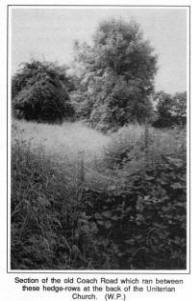 The
Ulsterbus Belfast to Dublin Express coach glides powerfully
away up Church Street. The passengers are cocooned in air
conditioned comfort and soothed by taped music. It all makes
a sharp contrast with the possible scenario in the Square
one hundred and thirty seven years ago. Then the horse drawn
Royal Mail Coach would have rattled and clattered down
Bridge Street and into the Square, pulling up to a noisy
halt outside the Post Office. Any alighting passengers would
have been both bone-shaken and travel-stained. The
Ulsterbus Belfast to Dublin Express coach glides powerfully
away up Church Street. The passengers are cocooned in air
conditioned comfort and soothed by taped music. It all makes
a sharp contrast with the possible scenario in the Square
one hundred and thirty seven years ago. Then the horse drawn
Royal Mail Coach would have rattled and clattered down
Bridge Street and into the Square, pulling up to a noisy
halt outside the Post Office. Any alighting passengers would
have been both bone-shaken and travel-stained.
Apart from these differences in comfort, the cost and the
time taken for the journey are also dissimilar. In the 19th
century the journey from Belfast to Dublin cost �3.5s.0d.
for two insider seats and took 13 hours to accomplish. Today
that journey can be done in 3 hours and costs �9.50 per
person, day return.
Slaters Commercial Directory of Ireland 1856 gives an
insight into coach and car travel from the town. The number
of people providing the service reveals competition for
passengers but there is no clue as to whether the "cars"
were Jaunting cars, side cars, brakes or worse!
Some of the departure times are also quite amazing. Can
you envisage a Royal Mail car leaving for Ballynahinch,
Comber, etc., every morning at twenty five past two? or
Belfast at ten minutes past four?
Amended extracts from Slaters "Commercial Directory of
Ireland" 1856
To Dublin The Royal Mail left from the
Post Office every morning at eight and a Coach every
night at eleven.
To Ballynahinch, Comber. etc.; The Royal
Mail car left from the Post Office every morning at
twenty-five minutes past two.
To Banbridge Cars from Edward McCartney's
(who was a butter factor as well as running the posting
establishment) Andrew Jelly's (a spirit and porter
dealer) and John Scott's (a surgeon in Bridge Street)
every morning at nine.
To Belfast The Royal Mail car, from the
Post Office every morning at ten minutes before four and
every night at a quarter to eleven.
To Lisburn A car from Edward McCartney's
every morning at a quarter past seven, arriving in time
for the Ulster Line of Railway train at a quarter before
nine and again occasionally leaving Dromore at nine; a
car from Andrew Jelly's every Tuesday and Friday morning
at a quarter past nine and one from John McGrady's at
the same hour; all go through Hillsborough.
To Lurgan Cars from Edward McCartney's, Andrew
Jelly's and John Scott's every Thursday morning at nine.
The running of some of these local cars to Lisburn and
Lurgan corresponds to the Market Days, Tuesday and Thursday,
in these towns.
By 1863, the coach/car service from Dromore had been
considerably reduced. This is probably indicative of the
number of people who now chose to travel on the Banbridge,
Lisburn and Belfast Co. railway line which had opened on the
13th July in that year.
The change is also reflected in this excerpt from the
Belfast and Ulster Directory for that year which advises us
of the following:
Conveyances
To Lisburn - Every morning, (Sunday excepted) from
Dawson's (Dawson was a car owner and spirit dealer) and
McCartney's in time for the first train and for the forty
five minutes past ten train to Belfast.
Curiously there appears to have been no road transport
between Dromore and Moira, the nearest rail station on the
Ulster line, even though a fairly good road between them was
mapped by Daniel Anderson as early as 1755.
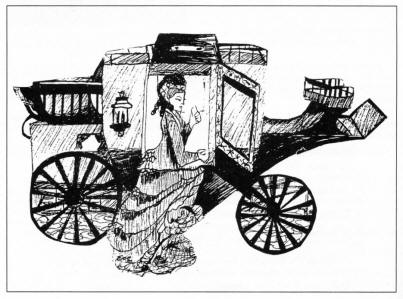

ALEXANDER COLVILL
WELSH
by Gilbert Watson
Alexander Colvill Welsh had an established business as
a glazier and painter in Dromore, Co. Down in the
nineteenth century but he enjoyed a much wider reputation
for his collection of antiquities. He was the son of
William Welsh of Dromore who married Jane Dickson the
daughter of Joseph Dickson and Jane Colvill, and the
great-grandson of Dr. Alexander Colvill. His paternal
grandfather was George Welsh who was born in Moira in 1720
and is buried in the Cathedral grave yard at Dromore along
with his two wives.
Alexander Welsh was also married twice. Firstly to Mary
Trail by whom he had three children; Anne
Blackwell, William and Jane.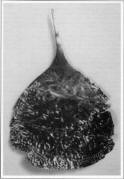
Mary died in 1838 and he
married secondly Anne Frazer by whom he had four
daughters, Anne born 1844 who married John Ellis; Alice
Margaret born 1848; Elizabeth Harberton who married a Mr.
Finlay; and Alice Jane born 1855 who married Richard
Watson of the Maze.
Welsh was a well known and respected collector and
antiquary and was very knowledgeable on the history of
Dromore and it is unfortunate that little of the vast
store of knowledge which he possessed is on record. He was
in correspondence with another noted collector Dean Dawson
of St. Patrick's Cathedral, Dublin, during the 1830's and
together with John Roggan of Ladies' Bridge was
instrumental in providing further material from the North
of Ireland for the Dean's collection.
Welsh viewed the Dean's collection during a visit to
Dublin in 1839 and he was so impressed by what he saw that
he admits in a letter that his own collection was lowered
in his estimation. The Dromore collection of artefacts was
viewed in the mid 1800's by John Roggan, who was so
impressed with the great variety and number of articles
that he composed and published "A Quaint Catalogue of
Antiquities in the collection of Mr. Welsh, Dromore,"
which is written in rhyming couplets. The full catalogue
is given below and indicates what a valuable museum of
treasures was once housed in Market Square

Huge folios and
quartos, heaped pile upon pile,
Then beautiful paintings in every style;
With maps of all countries and charts of all
seas,
He sees the whole globe while he sits at his
ease,
Can trace all its mountains, each river and
lake:
Describe every people, their colour and make-
With beast, bird, and insect, fish, reptile, and
all
That have an existence on this earthly ball.
His fossils are numerous, many, and rare
Even teeth of the lion, rhinoceros, and bear,
The head of an otter, and one of a fox,
Petrified hard as the primitive rocks;
Fragments, once oak, now certainly stone,
Petrified holly used oft as a hone;
Petrified ash and petrified yew,
Petrified thorn, and sycamore too;
Petrified urchins and petrified snakes,
Petrified fish, from both rivers and lakes:
Oysters and razor fish, too, petrified,
And limpets and muscles, and cockles beside;
Univalve, bivalve, and multivalve shells,
Curious stalactites, from grottos and cells;Dendritics, zoophytes, and belemnites too,
Corals and corallines, white green and blue,
Surphurs and salts, native metals and ores,
Curious pentacrinites, fine madrepores,
With some of the gems of Lough Neagh's sandy shores.
A pebble, the finest from Lough Lean,
And a neat little emerald of beautiful green;
Schists, fluors, and quartz, a handsome actite.
Silex, amygdaloid, ochre, and granite;
Gypsum, and pieces of Derbyshire spar,
And marble of various kinds from afar.
His boxes of earths all differ in hue,
From argill's dark red to fuller's pale blue;
'Tis pleasing indeed to hear him explain
The kinds best adapted for each kind of grain.
Ninety-eight amulets and thirty-two beads,
Many of which were used as decades
In form, orbicular, octagonal, square,
Of crystal, of amber, even pearl so rare.
Pieces of crosiers, a rare crucifix,
An old broken mitre, a chalice and pix;
A font was dug up near the Abbey of Saul,
And an old heathen idol, the rarest of all;
The pan of censer, of bronze finely polished,
Found near a church fierce Cromwell demolished;
|
And a square iron bell, so
injured by time,
No effort will cause it to yield the least
chime;
The parts are united with rivet and solder,
Than the famous Clogroe it's undoubtedly older.
Of rich polish'd brass, a rare antique
vessel,
I'm led to conclude it the bowl termed
"wassail,"
Brought here by some Anglo-Saxon invader,
Or left on our shore by an adventurous trader.
Two beautiful methers, a carousal cup,
From which the fell Ostman his boir would sup,
From heather fermented - so potent the juice,
Great draughts would inebriate and madness
produce;
The blood thirsty Pagan, with gore-covered
steel,
Would then make the natives his tyranny feel;
Nor ceased hath tradition the hardships to tell,
In those cruel times our forefathers befel.
Say, muse, were the bridle, bits, stirrups, and
spurs,
Used in King William's or Oliver's wars,
They may have belonged to some knight of old
Bessie,
Or seen the famed fields of the far famed Cressy.
He has pieces of greaves, shirts of mail and
vambrace,
A vizier and some other guards of the face,
Old gorgets and helmets, the half of a shield,
And a part of a sword from Canne's dread field;
Bills, battle-axes, old spears, and old skeans,
And dirks that were used on Colloden's Plains;
A gauntlet and glove near eaten by rust,
Were used in the days of Richard the First.
Of brass he has seventeen beautiful celts,
With sockets and ears, which hung from the belts
Of others quite plain exactly a score,
And hatchets of stone a hundred and more;
Of flint he has arrow heads, lances and spears,
The tedious collection of many long years.
A terrible axe was in sacrifice used,
When the Flamin the reason of mankind abused-
Six inches broad, half a cubit in length,
Of stone finely polished and form'd for
strength;
A statue of stone was found near the Nile,
An Egyptian god executed in style;
Beautiful Lachrymatories, well formed urns,
Adorned with lines of most curious turns;
An hundred old pipe to the Danes some ascribe,
Others doubt that they ever belonged to that
tribe.
|

He has various stone mills, one a beautiful quern,
Long, long, were they used by the sons of old Erin.
Two internal mummies of well baked clay,
And a Borneo idol to him found its way.
He has beautiful bracelets, brooches; and rings,
Which were worn of old by our Queens and our Kings;
A rare antique pin of Corinthian brass.
The head ornamented with fine ancient glass:
Such fastened the mantles of heroes of old,
And some were of silver and many were gold;
A large oval button of high polished jet,
Surmounted the pin where the Mantle folds met;
Two curious loops of the precious ore,
To fasten the doubtlet that Monarchs oft wore.
Of old Irish slippers he has got a pair,
Without sole or heel, to meet with how rare;
With thong most ingeniously stitched in front,
But one has some curious carving upon it.
Of matwork a singular fragment hath lain
In earth, I presume, since time of the Dane,
Most curiously wrought by some masterly hand,
Its original use how few understand:
'Tis compact in the texture as cloth nearly fine,
The fabric is wood, undoubtedly pine;
A part of a skull in an urn was found,
An inch near in thickness, and perfectly sound,
That centuries ten must have lain in the ground;
He has medals, medallions, and coins new and old,
of silver, of copper, of brass, and of gold;
Of gold he has seventeen coins mostly rare,
Three hundred of silver, some round and some square;
Of copper five hundred, one hundred of brass,
When James abdicated he caused here to pass;
The coins of the Popes our notice first claim,
I'm told that precedence is due to the name,
I think he has some of the fourth Adrian,
With others quite down to the last reigning King;
The Emperors next of course come in view-
of these he has German and Russian too,
And handsome Napoleons also a few;
A handsome medallion of Charlemagne,
With coins struck for Prussia, Poland and Spain,
A few struck for Sweden, by Charles and hot,
And some by that traitor to France, Bernadotte;
A number of those by the fell Bourbon Line,
With Burgundy, Tuscan, and Austrian fine;
Dalmatian, too, must be added to these,
And some of the Sultan's and some Portuguese;
Of Venice, Genoa, the Sicilies some,
And from Switzerland, Holland and Belgium they've come;
|
Of Charles the Rash, a beautiful coin,
Of William's a few, who fought at the Boyne;
Of all of the George's, of Mary and Anne,
Henry the Third, Seventh, Eight, and King John;
Two of the Edward's One, five the Confessor,
The Charles's Bess, and James the transgressor;
A beautiful sample of Scottish produce-
Alexander, the James's and David, and Bruce;
The coins of Old Erin appear, but, alas!
Of these he has few, save of copper or brass,
along with her rights her Antiquities fled,
Save such as she sunk round the graves of her dead:
what escaped the hand of the Ostman, so rude,
Was spoiled or destroyed by the bold Saxon brood;
Poor Man, too, exhibits here three brawny legs,
To be classed among Nations most anxiously begs;
When the coins of all Nations he marshals in ranks;
There's nothing but copper appears for the Manx's;
Thou Yankee, brave people, who would dare to be free,
He has paper and silver abundance of thee;
The arrows, the eagle, holds firm in its claws,
That Europe's proud despots triumphantly awes;
Thy coins, too, brave Hayti, tho' sable, thy race.
In his cabinet holds a conspicuous place;
Demerara, the Brazils, Barbadoes of thee,
He has many coins, and a handsome rupee;
Batavia, Java, and fertile Ceylon,
Thy coins make the shelves of his cabinet groan;
Thou far distant China, the nations how few
Can boast an antiquity equal to you
He has thirty-six of thy coins and thy medals,
Some bearing thy Emperors, other thy idols;
Tho' science its influence round thee hath shed,
Thy millions with Priestcraft are basely misled;
They worship in ignorance, tamely forego
Their reason, and bow to the poor idol Fo;
Besides the above he has many defaced,
By whom they were struck, nor their dates can be traced;
But still like the miser he adds to his store,
Though blest with abundance he still craves for more;
He digs up the Tumuli, raises the cairn,
To find something rare, and more knowledge to learn;
To search round the Cromlech, he long journeys takes,
Pursues the meanderings of rivers and lakes;
If fortune some antique will cast in his way,
His toil and his trouble it will more than repay;
|
The caves deepest corners he bravely explores,
In quest of some curious' crystals or ores;
Among Druid's circles, old mouldering towers,
He spends with delight some laborious hours;
Or seek old entrenchments, the place of the slain,
Perchance to find something of Saxon or Dane;
The abbey's wild ruins incrusted with moss,
The castle's rude walls, and the rath's ample foss
He constantly visits with diligent pry
In places like these, antiquities lie;
So, indeed, very little escapes his keen eye. |
Now cease gently muse for a moment or more,
Till I take a last look at this precious store;
I view this museum as historic pages,
Of artists, of heroes, of monarchs, and sages;
Even too of old nature, whose curious hand
Hath scattered such rarities over the land;
Were medals but struck for the worthy of fame,
No doubt Mr. Welsh to that honour might claim;
But monuments crumble, and medals will rust,
So his fame, worthy Sirs, to the muse we will trust. |

July 11th, 1840.
Welsh's collection and interest was never static and
his travels included visits to Dublin and Edinburgh. He
was continually adding to the quality and variety of
articles and a new pursuit in 1839 of collecting
"different sorts of newspapers" was built up to 271 in a
short time. His tenacity in the pursuit of artefacts is
illustrated by his admission that it took over ten years
to procure a square iron bell found in a Forth outside
Dromore and his eventual success, in acquiring it from the
lady owner, was the result of barter involving a silver
crucifix which "she thought more useful." On another
occasion, his business acumen is demonstrated in his
attempt to acquire an inscribed bell (the Clog Ban) from a
catholic family by enlisting the support of his
father-in-law who was "much thought of by the Roman
Catholic party owing to his political principles" and was
also intimate with the Priest who lived next door to the
vendor.
At the British Association for the Advancement of
Science Exhibition at the Museum, Belfast in 1852 Welsh
displayed various exhibits and the following have Dromore
connections.
(a) Portions of an ancient conical Cap of closely
woven rushes, found with a stone Axe, in Drumbroneth
bog, near Dromore.
(b) Three tri-handled cups, of black glazed pottery,
found in the original burying-ground of Dromore.
(c) Illustrative American Indian Arrow-head of flint,
with which the late Dr. Gillmer, of Dromore was wounded
in the leg.
Part of Welsh's collection of antiquities was acquired
by the Royal Irish Academy in March 1876 and was
subsequently transferred to the National Museum of Ireland
in the late nineteenth century. It consisted of some
several hundred archaeological objects ranging from flint
tools to bronze pins and brooches of the early Christian
period and prehistoric period pottery vessels.
The following description of the gold ornaments in the
Welsh collection is given in George H. Bassett's 1886 Co.
Down guide and directory and the sites in the vicinity of
Dromore where the specimens were found are recorded.
"In the Royal Irish Academy (Dublin) collection of
Irish Gold Ornaments, are some from the County Down. They
belonged to the late Mr. A. C. Welsh of Dromore. The
first, a spoonshaped object, one and eleven sixteenths of
an inch in width, and two and three-quarter inches long.
It is slightly concave, and has a slender tang with triple
row of small punched dots, near the edge. It weights two
pennyweights and sixteen grains. The second was a bowed
object and disc terminations and copper core; one disc
gone. It was found at Edenordinary. The third is a
specimen of ring money, a quarter of an inch thick and
threequarters of an inch in diameter six pennyweights and
three grains. The fourth is an unclosed hoop-shaped ring,
with copper core having double longitudinal flutings. The
core is visible to the extent of a quarter of an inch at
the centre of the circumference. It is five-eights of an
inch in diameter, a quarter of an inch in width,
two-tenths of an inch in thickness, and weights two
pennyweights and ten grains. It was found at
Ballymacormack.
Welsh was aware of the value of his collection as his
will dated 2 February, 1876 stated his intention "to make
provision for my wife and her children by my second
marriage by the sale of my antiquities and curiosities and
therefore they are not named in this my will as Legatus."
The beneficiaries were his own son William, his daughter
Jane and his nephew William Price. The will gives an
indication of the property he possessed, namely a tenement
in Market Square occupied by Hugh Herron, a tenement
garden in Gallows Street, a house in Mount Street occupied
by Betty Jane Kennedy, a tenement in Gallows Street
consisting of two houses and gardens occupied by David
Thompson and John Prentice as well as his residence in
Market Square.
Welsh's knowledge of Dromore has already been referred
to, and one of the few known articles by him is a letter
dated April 24, 1843 published in The Nation newspaper on
the subject of The Break of Dromore. The same account of
The Break is given in a footnote to the Montgomery
Manuscripts by the editor the Rev. George Hill who refers
to the account coming from an unsigned letter dated 24th
April, 1843 found among the papers of the noted historian
Mr. Samuel McSkimin of Carrickfergus. The account is that
of Alexander C. Welsh and his letter to the Nation was
probably at the request of the editor John Mitchell, the
Young Irelander. Welsh would have known Mitchell as his
cousin Robert Dickson was married to Mitchell's sister.
The introduction to the newspaper article is probably by
John Mitchell.
"The following curious and valuable information we have
just received from a Conservative friend, who, in adverse
circumstances, has acquired a knowledge of history, art,
and numismatics, a collection of antiquities that might
excite the envy of many a man with a great name:

April 24, 1843
Sir-You must think me a great procrastinator, or very
ungrateful, when I did not answer you kind favor sooner.
The truth is, after having made every inquiry from all the
oldest inhabitants of this place, I declined writing
relative to the "Break of Dromore" until a person who was
from home would return, he being one I depended more on
for information, as one of his ancestors was likely to
have suffered death on a charge of embezzling some of King
James' stores, so that many of the occurrences of 1690
were handed down by the family.
From all the information I can collect, I am come to
the conclusion that the flight at Dromore took place in
the townland of Ballymacormack, immediately adjoining the
town. The new line of road that passes through Dromore,
from Dublin to Belfast, bisects the battle field. It
occupied but a small space on the south side of the
Gallows-hill though not on a level, but a kind of glacis,
terminating at a bog-a place not ill chosen for a
skirmish, such as we may suppose it to have been, for
neither could have had much the advantage as to position.
General Hamilton's men were protected on their right by
the common-bog, and a small party in the narrow (Gallows)
street would have been sufficient to keep them from being
flanked on their left. The Protestant party had the bog on
their left; but their right lay open for attack. About two
hundred yards to their rere la Crows-wood, into which they
retreated when repulsed, and from thence they dispersed,
part of them passing the eastern extremity of the bog, and
made their way over Cannon-Hill, on the opposite side of
which lay the leading road to Killileagh and Donaghadee,
from whence some embarked for Scotland. What road the
remainder took I could not ascertain.
But the whole action must have occupied a very short
space of time; for according to tradition, a woman went
out to see the flight when it commenced, left bread to
bake at the fire, returned after the affray had
terminated, and during her absence the bread was not
burned. I conjecture none of the inhabitants of the town
were in the action; or if any, I will presume to state
that none of them fell. My reason for stating so is, had
any of then been killed in such a politico-religious
occurrence, their graves to this day would be pointed out,
and many is the tale of their great prowess would be
related, as the present churchyard was then the only
burying-place in the parish. And what strengthens me in my
opinion is, that a mile from Dromore, in a field on the
right hand side of the old turnpike road leading to
Hillsborough, a grave is there pointed out, green to this
day, said to be that of Marian De Ell, or De Yel, who, for
refusing some of James's soldiers a drink of buttermilk,
before she had taken off the butter, was drowned by them
in the churn, with her head downwards. And about
half-a-mile farther on, in a field on the opposite side of
the road, is another grave, said to contain the remains of
one Campbell, a powerful man, who, armed with only an old
sword, opposed part of James's army; but was soon
overpowered by numbers, thrown over the ditch, and buried.
(Query - When James's army passed, why did the friends of
the deceased suffer them to remain there, but have them
interred in consecrated ground?).
However, in this instance, I differ from tradition. I
rather think the graves alluded to are those of the two
soldiers of William's army, who, according to the Rev. G.
Story, "were shot near Hillsborough for deserting." Story,
or his informant, might have been in the rere of the army
at Hillsborough when the account reached him, and caused
the mistake, placing the transaction nearer that place
than Dromore, nor do I think the mistake improbable as the
two places lay only four miles distant, and Hillsborough
being a garrisoned town.
I have felt a pleasure in being called on to collect
the account of the "break;" for these notices, trifling as
they may appear were collected from the only remaining few
of the old inhabitants who are fast hurrying from the
scenes of this life to mix with the kindred dust of their
ancestors, who, in their turn, witnessed the scenes I have
written of.

In order to make you more acquainted with the
localities, I give the following notes:
Gallows-hill and Gallows-street
(formerly the leading road to Hillsborough through
Dromore). I conjecture they are corruptions of Galgas-hill
and Galgas-street, as the name of the town was
originally Ballynagalga.
Crows-wood was a few acres of land
then in a state of nature, covered with trees and
brushwood, commencing at the Eastern extremity of the
common bog, and extended up the hill on which the battle
was fought. It still goes by the name of Crows-wood,
although it is divested of all the timber, and in a
state of cultivation.
Cannon-hill situated on the
opposite side of the narrow valley from Crows-wood (and
in form of an inverted bowl), rises to an elevation
higher than some of the surrounding hills, from the top
of which is a fine commanding view of the town, and
about a half mile distant.
Cannon, or even musketry, from
this hill could have annoyed the enemy when in action;
probably those who fled to Killileagh might have
previously come from that part, and as this was their
direct road, it is likely part of them had been posted
here with cannon, if such they had; not is it unlikely
that it was a concerted plan with the proprietor, Mr.
William Holtrige, of Dromore, merchant, then a leading
character, and one of those mentioned in James's act of
attainder. The name of this hill partly proves the
circumstance, though I remember, when in infancy, to
have heard that the name was given it in consequence of
Cromwell's men placing cannon on it, and from whence
they destroyed the old castle and town; but we have not
the slightest historic foundation for the occurrence.
I would give credence to the account of those who fled
seeking refuge in Scotland; for an old lady, who has seen
some summer suns over ninety, who enjoys all her mental
faculties, recited to me the two following lines of a
popular song in her infant days, relating to the war of
1690.
`The run at Loughbrickland, the break of
Dromore,
Made Sandy and Willy take both to the shore.'
The last word in memoriam to Alexander Colvill Welsh,
who died in 1877 and is probably interred in the Cathedral
graveyard, we leave to J. W. Montgomery of Downpatrick who
in his poem Dromore in Rhymes Ulidian refers to the great
collector.

DROMORE
Tread softly, stranger,
o'er the ground,
And true obeisance pay;
For here lie buried men renowned
And brilliant in their day,
The bones of one well known to fame,
Within these vaults repose;
On history's page is graved his name
Ingrained with Erin's woes.Loved Taylor, Bishop
of renown,
His useful earth-course run,
Beside the Lagan laid him down,
The brighter life begun,
Stay, comrade, stay, nor grudge the tear
That by such tomb is shed;
Thy Welsh might well be buried here
Where sleep the glorious dead.
Light lie the turf on Walsh's grave,
By Dunum's whispering streams;
Thou moon, reflected in the wave,
Benignly fall thy beams;
Still shed a lustre round his head,
And through the long, cold night,
Above the clammy tombstones spread
A veil of silver light. |
Oh, raise thy voice,
famed Druim More,
And honour him now dead;
Thy choicest gems he held in store,
And walked, in deep things read-
Could trace thy life in days of old,
And all thy history tell,
Through age of bronze, or age of gold,
And words of ogham spell.His fall hath swept much
lore away;
For though oft pressed to write
Those thoughts he gave one by the way,
(All held so worthy light-
Ay, sometimes worth their weight in gold!)-
Still modesty was there,
To keep the treasured tale untold,
While we the loss must bear.
O rare collector, lying low!
All worthy of the bays;
Ye winds that round our Alick blow,
A solemn requiem raise:
The never-ceasing gleaner's gleaned,
By death's sharp scythe cut down;
From common life-walks, early weaned,
He worked, and won the crown! |
 BIBLIOGRAPHY
A Ramble Through Dromore. John F. Mulligan 1886.
The Nation 13th May, 1843.
A Quaint Catalogue of Antiquities in the collection of Mr.
Welsh, Dromore. John Roggan 1840.
Rhymes Ulidian. J. W. Montgomery 1877.
County Down A Guide and Directory 1886 by George Henry
Bassett.
Will of Alexander Colvill Welsh dated 2nd February, 1876.
Will of Jane Welsh dated 18th January, 1905.
The Montgomery Manuscripts (1603-1706) Edited by Rev.
George Hill.
British Association for the Advancement of Science, Sept.
1852, Descriptive catalogue of the Collection of
Antiquities exhibited in the Museum, Belfast.
Welsh Collection, Summary list, National Museum of
Ireland.
Correspondence from Nessa O'Connor and Mary Cahill, Irish
Antiquities Division, National Museum of Ireland, Kildare
Street, Dublin 2.
Welsh/Dawson correspondence in the Royal Irish Academy,
transcribed by Winifred Glover, Ulster Museum, Belfast.

PLEISTOCENE PARK
The Story you have waited 12,000 years to hear!
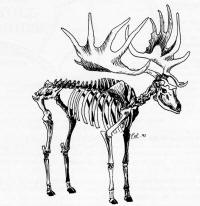 The inability, or perhaps sheer cussedness, of one of my
siblings, to pronounce my church given name, resulted in
the title "Moose" being bestowed on me in my early
childhood. You will understand then, why my attention
was inevitably drawn to the words "Moose-deer" while
reading an extract from W. W. Sewards, "Topographica
Hibernia" 1795. The inability, or perhaps sheer cussedness, of one of my
siblings, to pronounce my church given name, resulted in
the title "Moose" being bestowed on me in my early
childhood. You will understand then, why my attention
was inevitably drawn to the words "Moose-deer" while
reading an extract from W. W. Sewards, "Topographica
Hibernia" 1795.
He records, that in 1783, a pair of
moose deer horns, measuring 14 feet and 4 inches from
tip to tip, were found on the see lands of Bishop Percy
of Dromore. Almost the whole skeleton of the animal that
wore them was unearthed and "computed to have been
almost 20 hands high".
Without modern scientific skills, Seward tells us that
it was unknown when these animals existed, but he does
say that their remains are usually found in the stratum
of marl covered by bog.
Marl is a term for clay containing the remains of shells
and it is now known that, after the last retreat of the
Ice from Ireland, there were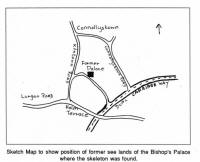 numerous fresh water lakes
in which such clays were deposited. numerous fresh water lakes
in which such clays were deposited.
At this period Ireland was an integral part of Europe
and great deer roamed over the Continent from the
Atlantic to the Baltic. The skeleton was therefore most
likely that of an Irish Deer or Megaceros - akin to the
moose of North America. A continuing warming up of the
climate may have been the cause of the demise of these
graceful and well proportioned animals.
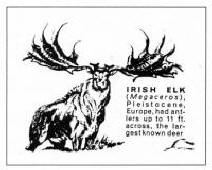 As the marls
dried out and became stickier they simply mired down in
them, or perhaps an epidemic distemper occurred. The
growth of forests may have sealed their fate, for while
sheltering their natural enemy, the wolf, they also
reduced the deer's feeding grounds by preventing them,
with their wide horns from entering. As the marls
dried out and became stickier they simply mired down in
them, or perhaps an epidemic distemper occurred. The
growth of forests may have sealed their fate, for while
sheltering their natural enemy, the wolf, they also
reduced the deer's feeding grounds by preventing them,
with their wide horns from entering. As this is now
within measurable time distance of the present day,
approximately 10,000 years ago, it has been suggested
that the first Irishmen may have seen the Great Deer
before it disappeared - The Gaelic term Danik-ailta
translates as wild-ox, but this may refer to another
species. On the other hand doubts have been expressed
that they lived long enough to be contemporaneous with
man. In any event Dromore man encountered their
remains over 200 years ago and according to S. Lewis in
his "Topographical Dictionary of Ireland" 1837 the
skeleton was placed in the Bishops palace where it was
carefully preserved.

THE TOLL HOUSE
by
Rosemary McMillan
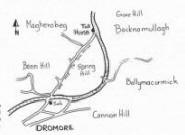 This
toll house was probably built in the 1740's This
toll house was probably built in the 1740's
The construction, by the Turnpike Trust, which existed
between 1733 and 1857, of a new stretch of road between
Dromore and Hillsborough, did not affect the site, or
the use of, the building. In the townland of Backnamullagh, the remains of this
turnpike road cross the present dual-carriageway from
N.E. to S.W. continuing on towards Dromore by way of
Mile Bush Road. -formerly the old Hillsborough Road. The toll house sits in the angle of this crossing and it
is thought to have continued to operate as such until
the Turnpike System was abolished in the 1850's. Unfortunately, we have omitted to preserve the Palace
and so our Dromore Megaceros has once more gone to earth
unless someone knows otherwise! -"Moose" McMillan.
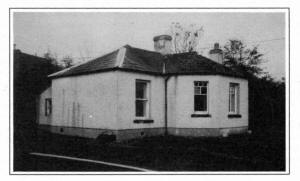

JEREMY TAYLOR
By Mark Hobson Jeremy Taylor was the third son of Mary
and Nathaniel Taylor, a barber to trade. He was born in
Cambridge and baptised there in Trinity Parish Church,
on the 15 August 1613. At the age of three years the
young Jeremy was sent to Grammar School in Cambridge.
Then at the age of fourteen he entered Caius College as
a SIZAR, and when he was twenty years old he obtained an
M.A. degree. As a youthful twenty-one year old a
dispensation was obtained in his favour and two years
before the Canonical age of twenty-three, he was
admitted to the Holy Orders. Jeremy Taylor then began to
preach with authority, power and sweetness. At that time
William Laud was Bishop of London, in 1663 he became
Archbishop of Canterbury. Jeremy Taylor continued with
his studies and preaching. On a friend's recommendation
he preached at Saint Paul's Cathedral in London where he
attracted the attention of the Archbishop of Canterbury.
He was then sent to Oxford where, under the guidance of
the Archbishop of Canterbury, he became a fellow of All
Souls in January 1636. Then in 1637 he was presented by
Bishop Joxon to the Rectory of Uppingham in Rutlandshire.
He was also appointed Chaplin to Charles I. While living
at Uppingham he made visits to Oxford and to the Court
of Charles I. On the 27 May 1639, he married Phoebe
Landisdale or Langsdale. In 1640 his great patron Laud
was sent to the tower for religious arguments with the
King and Parliament.
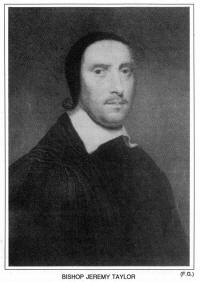 Taylor and his wife continued to live at the Rectory in
Uppingham, where Phoebe gave birth to a son. Sadly this
first child, William, died. From this quiet but un-safe
retreat he heard the distant mutterings and the loud
approaching roar of the troubles of the Civil War. The
Solemn League and Covenant had been formed in the year
of his appointment to Uppingham and the long Parliament
summoned. Jeremy Taylor carried on with his writing and
preaching. When the war began in 1642 he was writing
"EPISCOPACY ASSERTED", his home was pillaged and his
living taken from him. In the year 1642 King Charles I
read Jeremy Taylor's book prior to publication. He did
not, however, permit the writer to dedicate the book to
him. The book was called "OF THE SACRED ORDER AND
OFFICES OF EPISCOPACY" (1642). Taylor and his wife continued to live at the Rectory in
Uppingham, where Phoebe gave birth to a son. Sadly this
first child, William, died. From this quiet but un-safe
retreat he heard the distant mutterings and the loud
approaching roar of the troubles of the Civil War. The
Solemn League and Covenant had been formed in the year
of his appointment to Uppingham and the long Parliament
summoned. Jeremy Taylor carried on with his writing and
preaching. When the war began in 1642 he was writing
"EPISCOPACY ASSERTED", his home was pillaged and his
living taken from him. In the year 1642 King Charles I
read Jeremy Taylor's book prior to publication. He did
not, however, permit the writer to dedicate the book to
him. The book was called "OF THE SACRED ORDER AND
OFFICES OF EPISCOPACY" (1642). During the war, Taylor
marched side by side with Pearson and Chillingworth,
under the Royal Standard for King Charles I. He helped
to stir up the spirits of the fainting Royalists with
his sermons, as well as caring for the sick and wounded.
He was imprisoned twice during the Civil War, but was
treated with no great severity. Then in 1644, while
commanding an army for the King, he was defeated by
Laugharne, a Superior General. He then made his peace
with Parliament and received a Pardon. Whereupon he
retired to Carmarthenshire, where, being a celebrated
man of letters, he opened a school. His wife Phoebe died
in 1650. Now in retired life he was able to concentrate
on his writings. He was not entirely debarred from the
society of the good and the noble, for at Golden Grove,
in the same parish, there dwelt a nobleman who was kind
to the exiled clergymen. It was at Golden Grove that he
wrote his most famous works of all which were "THE HOLY
LIVING", "THE HOLY DYING" AND "THE LIBERTY OF
PROPHESYING". In time he then married Joanna Bridges a
lady of some property, and ceased teaching. Jeremy
Taylor was imprisoned in Chepstow because of his writing
about the church and religion. He was eventually
released from prison in the autumn of 1655. He spent a
short time at Mandinan and also some time in Wales,
where he wrote "A DEFENCE OF THE LITURGY", at the
request of the King. Then, in the year 1656 towards the
end of the Lord Protector's rule, Taylor went to London
where he was imprisoned in the Tower because of a
mistake which his publisher had made. They had rashly
prefixed to a collection of papers a representation of
Christ in the attitude of prayer. This offence was
punishable by a heavy fine or imprisonment. At this time
Taylor wrote his most elaborate piece of work, "DUCTOR
DUBITANTIUM", (a guide for the doubtful), which was a work
of some controversy. On his release from the Tower having
paid sufficiently for what he had written, he left England
in 1658.

He was encouraged by Lord Conway to settle in Ireland and
take up residence at Conway's princely mansion at Portmore
on the shores of Lough Neagh. Near Ballinderry lies the
ruined church and castle of Portmore. The castle of Portmore
was built in 1664 by Lord Conway on the remains of an
O'Neill Fort. Possession of the castle had then passed on to
his cousin Popham Seymour in 1683 and later to his brother
in 1699. He died in 1731 or 1732 and was succeeded by his
eldest son Francis, 1st Marquess of Hartford. The castle at
Portmore was demolished in 1761. The church at Portmore is
built on an artificial Island surrounded by a ditch and a
double hedge. Many people think that it is the "half ruined
church of Kilutagh" where Jeremy preached, while others
thinks that it is Templecormac. Even at Portmore under the
protection of Lord Conway he was not safe from arguments. In
1669 he was arrested and sent to Dublin for trial. The
charge brought against him was that he had used the sign of
the cross in administering the sacrament of Holy Baptism.
The charge was brought by a Presbyterian from Hillsborough
called Tandy. However, the authorities in Dublin did not
take the charge seriously and it was not long before Jeremy
Taylor was back at Portmore. The church in Dromore was the
"Church of Saint Colman" and it was attached to the
monastery. Under the charter of James I in 1609 it became
known as "THE CHURCH OF CHRIST THE REDEEMER", or,
"CATHEDRALIS CHRISTI REDEMPTORIS DE
DROMORE". During the rein of Elizabeth I the Cathedral
was in ruins and remained in that condition until James I
refounded the See by the Letters of Patent, which gave the
Bishops extensive land possession. In 1641 the Cathedral was
destroyed and it remained in ruins until 1661 when Charles
II gave Jeremy Taylor permission to rebuild the Cathedral.
In 1660 Jeremy had a complete change of fortune. He was
appointed Bishop of Down and Connor, and from his next visit
to Dublin in 1661 he returned as Vice-chancellor of the
University of Dublin. Also in January 1661 on the day of his
Consecration in Saint Patrick's Cathedral in Dublin, two
Archbishops and ten Bishops were consecrated by Archbishop
Bramhall. Jeremy Taylor preached the sermon on the day he
was consecrated. Bishop Lesley's episcopate in Dromore was
of too short a duration to effect any changes. In June 1661
Bishop Lesley was transferred to Raphoe, and he was
immediately succeeded in the administration of Dromore by
Doctor Jeremy Taylor. The Cathedral was in ruins when he
came to Dromore. At his own expense he rebuilt the cathedral
on the site of a Sixth Century monastic site. Local
whinstone was used in the building of the Cathedral. It was
one hundred feet long by twenty feet wide, (covering what is
now the Tower aisle). Jeremy Taylor also lived at
Hillsborough Castle with his friends the Hills. He used to
say his prayers in the fort and when the fort was remodeled
for family feasts and parties, an ornamental gazebo was
built in the middle of the North rampart in the Bishop's
memory. The windows resemble those of the parish church
which he had consecrated in 1663. Jeremy Taylor's career
was cut short because he contracted a fever while
ministering to a sick man on the 3rd August, 1667. He died
at his residence at Lisburn on the 13th August, 1667, and
was laid to rest on the 21st August, 1667 in Dromore
Cathedral by his friend
George Rust, although he had wanted to be buried in his
new church at Ballinderry where a grave had been
prepared for him. Taylor did not live to see his new
Church finished, in fact it was not consecrated until
the year after his death. Jeremy Taylor died aged
fifty-four. In his will he left ten pounds to the poor
in Dromore. He stated in his will "Bury me at Dromore".
He was survived by his wife Joanna and three daughters.
In the vestry at Dromore Cathedral there is a Paten and
a chalice both made out of silver. Jeremy Taylor's wife
Joanna presented them for use in Holy Communion. The
following inscription is engraved on both of them,
"IN MINISTERIUM S. S. MYSTERIORUM IN ECCLESIA. CHRISTI
REDEMPTORIS DE DROMORE."
"DEO DEDIT HUMILLIMA DOMINI ANCILLA D. JOANNA TAYLOR."
Jeremy Taylor and his
wife are buried in the vault underneath the chancel in
Dromore Cathedral. The Bishop's Throne in the Cathedral
is a memorial to Bishop Taylor. George Rust became
Bishop of Dromore after the death of Jeremy Taylor, who
had ruled the Diocese for just under seven years.
On Thursday evening the 5th June, 1958 the memorial
lecture to Bishop Taylor was inaugurated in Dromore
Cathedral. The instigation of this was the then Rector,
Canon R. W. Kilpatrick, who later became Dean of
Dromore. The memorial lecture in memory of Bishop Jeremy
Taylor, continues to be held each year. Jeremy Taylor
was a celebrated man of letters and he was also a Godly
man. He worked throughout the Diocese in helping the
poor and the sick. He also helped to rebuild the
churches and reassert the Christian faith among the
people in his Diocese.
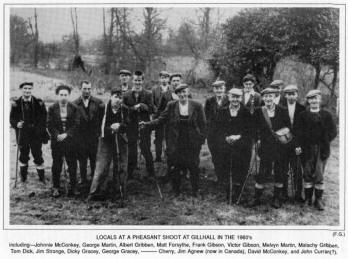
LOCALS AT A PHEASANT SHOOT AT GILLHALL IN THE 1960's
including--Johnnie McConkey, George Martin, Albert
Gribben, Matt Forsythe, Frank Gibson, Victor Gibson,
Melvyn Martin, Malachy Gribben, Tom Dick, Jim Stronge,
Dicky Gracey, George Gracey, Cherry, Jim Agnew (now in
Canada), David McConkey, and John Curran(?).

BREWERY LANE
A BREWERY WITH A COVENANTING CONNECTION
by Robert McCollum
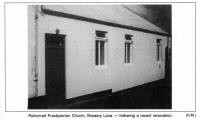 The
mention of Brewery Lane conjures up different images in the
minds of Dromore folk. Those who have come recently to live
in the town probably associate the name with the pensioners'
bungalows on either side of the street. But to Dromore
residents, born and bred in the district, the name bears
with it much wider associations. The
mention of Brewery Lane conjures up different images in the
minds of Dromore folk. Those who have come recently to live
in the town probably associate the name with the pensioners'
bungalows on either side of the street. But to Dromore
residents, born and bred in the district, the name bears
with it much wider associations. Before the bungalows were
erected by the Housing Executive in the 1970's the street
was much narrower and therefore appropriately designated, a
lane. On either side of this lane stood neat rows of
two-storey terrace houses. In the middle of the right-hand
terrace David Martin had a coal yard out of which he ran a
successful coal delivery business. Brewery Lane will
forever live in the memory of some Dromore citizens as a
source of employment. The lane terminates at the entrance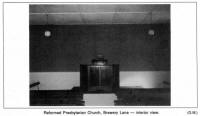 to a hem-stitching factory which produced a selection of
linen tablecloths etc., which, not only supplied the local
market, but were exported to many parts of the world. With
the closure of the business in 1991, due to difficult
trading conditions, the factory buildings have been
demolished and the site is open for redevelopment. At
present the possible erection of a nursing home is being
pursued by a firm of developers.
to a hem-stitching factory which produced a selection of
linen tablecloths etc., which, not only supplied the local
market, but were exported to many parts of the world. With
the closure of the business in 1991, due to difficult
trading conditions, the factory buildings have been
demolished and the site is open for redevelopment. At
present the possible erection of a nursing home is being
pursued by a firm of developers. The name of this
particular street has always been associated with the place
of worship which has occupied a site adjacent to the factory
for a century. This is the Reformed Presbyterian Meeting
House, otherwise known as the Covenanters. The history of
this place of worship is very much associated with the
denomination to which it belongs. The Covenanters trace
their roots back to the Scottish Reformation. In the 17th
century the general population in Scotland, through
subscribing the National Covenant of 1638, covenanted their
church and nation to Christ. This concept of a church and
nation covenanted to Christ was anathema to the Restoration
King, Charles II, and from the outset of his reign (1660) he
embarked on a policy of persecution against those who
adhered to Covenanting convictions. After 28 years of bitter
repression, in which 18,000 suffered by death, banishment or
being reduced to absolute poverty, relief was obtained in
the Williamite Settlement of 1688-90. The Settlement,
however, gave no place for a covenanted church and nation
and a minority of the population remained separate from the
Revolution Church to maintain this vision. These are
covenanters who in Ireland and Scotland, and subsequently in
other parts of the world, were formed into the Reformed
Presbyterian church. Christians with covenanting
convictions have been associated with Dromore for most of
the history of the denomination's existence in Ireland. One
of the first Covenanting ministers ordained in Ireland was
the Rev. William Staveley and the Call that was issued to
him in 1772 came from the "Covenanted electors between the
Bridge of Dromore and Donaghadee in the County of Down".
Although resident in Knockbracken, Staveley exercised an
itinerant ministry which extended from Co. Down to the
Counties of Armagh, Monaghan and Cavan. The Covenanters in
Dromore would benefit occasionally from his ministry. At
this time in the history of the Reformed Presbyterian Church
small groups of Covenanters living in a locality were formed
into Societies for mutual spiritual support and fellowship.
Dromore was no exception and the first record of these
Societies being involved in Calling a minister of their own
is found in the Minutes of the R. P. Synod for 27th May,
1812:

The Minutes of the Southern Presbytery report
that the Societies in the vicinity of Dromore,
hitherto unconnected with any congregation had
become attached to the congregation of Rathfriland,
which Congregation had presented a Call to the Rev.
John Stewart - that he had accepted of it and was
installed to the Pastoral Charge of the congregation
of Rathfriland and Dromore on Monday, 25th May,
1812.
This arrangement with Rathfriland existed until the death
of Mr. Stewart in 1837. This occurrence appears to have
prompted the Dromore covenanters to Call their own minister.
Having called licentiate James Steen this young man was
ordained to the gospel ministry in Dromore on 4th June,
1839. This settlement in Dromore may have been part of the
motivation which caused Rev. James Dick, at the Synod
meeting in July 1839, "to give notice of motion for the
formation of a Fifth Presbytery, comprising the
congregations of Dromore, Bailiesmill, Knockbracken, 2nd
Belfast and Ballyclare". Dissension in the Synod of 1840 and
the subsequent departure of the Eastern Presbytery to form a
separate denomination - the Eastern Reformed Presbyterian
Church - caused Mr. Dick to withdraw his motion. Although no
details are recorded of the size of the congregation in 1839
we can assume it bears some relation to the statistics given
for Dromore in 1854. The Drornore congregation consisted of
2 elders, 3 societies, 14 families and 45 members with an
annual income for congregational purposes of �16-4-0 and
�2-3-0 for missions. Mr. Steen's connection with the
congregation was short lived for in the report of the
Southern presbytery to Synod in 1840 the following paragraph
is included:
Presbytery are sorry in having to report, that at
its last meeting, the Rev. James Steen petitioned
for a disannexion from the congregation of Dromore,
as its pastor, on the ground of the unpromising and
hopeless state of the congregation. The Presbytery,
before taking up the case, thought it advisable to
hold a visitation Presbytery, at Dromore, for the
purpose of investigating more particularly the state
of the congregation, in order to decide on this
matter: this meeting is to be held on the first
Tuesday of August next.
At this meeting Mr. Steen resigned. He joined the General
Assembly the following year and was installed in Clonduff
Presbyterian Church on 21st June, 1842 where he ministered
for 39 years. After Mr. Steen's ministry Dromore never had
its own minister again and had to depend on pulpit supply,
sometimes on a very irregular basis. For example, the
Southern Presbytery report to Synod in 1843 reads:
The vacancies of Grange and Dromore, and the
Society in Dublin, have received some supply of
ordinances from us during the course of the past
year.
Better provision was made for Dromore in 1845 as is
reported by the Presbytery to the Synod.
According to an arrangement approved of by
Presbytery the vacancy of Dromore has been taken
under the pastoral care of the Rev. J. W. Graham,
for one year, and supplied with sermon every fourth
Sabbath.
Mr. Graham was the minister of Bailiesmills congregation
who, with his congregation, was received into the Southern
Presbytery from the Eastern in 1840. This arrangement with
Mr. Graham seems to have continued until his death in 1862
when Bailiesmills returned to the Eastern Presbytery.
Recognition is given to Mr. Graham's service in Dromore in
the 1850 Presbytery report.

The vacant congregation of Dromore has enjoyed
preaching about half time during the past year from
members of Presbytery and Licentiates, including the
ministerial labours of Mr. Graham one Sabbath in the
month, although no pastoral relation, strictly
speaking, has as yet, been formed between him and
that people.
At this time the Presbytery apparently had grounds for
encouragement in the work among the Dromore Covenanters.
Excerpts from the reports to Synod in 1851 and 1853 give
reasons for optimism.
Presbytery has under its care the vacancy of
Dromore, which has been supplied with preaching
about half-time. The adherents to our cause in that
place although not numerous appear steady, not
withstanding the many difficulties with which they
had to contend for many years. (1851) During the
past year the vacant congregation of Dromore has
been supplied with a preached gospel almost every
alternate Sabbath; the members in that locality
continuing warmly and steadfastly attached to a
covenanted cause and testimony, and giving regular
attendance on the ordinances of Divine institution.
(1853)
The tone of Presbytery's report in 1856 is altogether
different.
Dromore has received as formerly the preaching of
the Gospel every third Sabbath, and the ordinance of
the Lord's Supper was celebrated there on the third
Sabbath of August last, not without some evidences
we trust of the presence of the Master of
Assemblies; still, with sorrow we are compelled to
state, that our cause does not seem to be making
much progress in this place, there appears to be a
considerable amount of deadness, and besides some of
the most active and influential members of our
Church there, have in the inscrutable Providence of
God been removed by death, thus leaving a void not
easily supplied. Still we know that the residue of
the Spirit is with God, and he, by breathing on even
dry bones, can cause them to live.
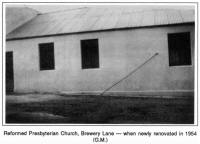 The
witness, however, continued and from church records it
appears the present meeting house in Brewery Lane came into
the possession of the Covenanters in 1881. The property was
sold by John and Robert Harrison to the church which was
represented by John Wright Hawthorne and Thomas Hawthorne of
Fedney, Josiah Archer of Ballymacbrennan (farmers) and John
McEwen of Dromore (tailor). The
witness, however, continued and from church records it
appears the present meeting house in Brewery Lane came into
the possession of the Covenanters in 1881. The property was
sold by John and Robert Harrison to the church which was
represented by John Wright Hawthorne and Thomas Hawthorne of
Fedney, Josiah Archer of Ballymacbrennan (farmers) and John
McEwen of Dromore (tailor). In 1898 Dromore was
transferred to the care of the Eastern Presbytery and became
associated with the work of the Dromara congregation. The
monthly service became the responsibility of the Dromara
minister. This arrangement worked well for almost a century
until in 1990 a committee of the Eastern Presbytery was
given the responsibility for oversight and services are now
being held weekly. Whatever the future of the Covenanter
witness in Dromore it is likely to continue in Brewery Lane
for the fellowship has had plans drawn up to erect a new
meeting house when the site is redeveloped. Research into
Brewery Lane has not revealed anything about what gave the
street its name. Obviously there must have been a brewery
there at some time. Did the Harrisons produce beer in the
present meeting house before it became a place of worship?
Might there even be an old still under the floorboards? Some
of the readers of this journal may be able to reveal some
information so that the mystery of the brewery in Brewery
Lane may finally be solved.

MY GRANDA AGNEW
by Sam Johnston
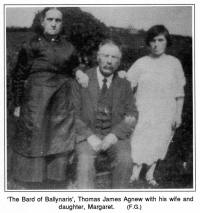 As
my paternal grandfather died before I was born, I somehow
felt shortchanged when I discovered that other boys had two
grandfathers. As
my paternal grandfather died before I was born, I somehow
felt shortchanged when I discovered that other boys had two
grandfathers. Perhaps that was why I cherished and adored
my grandfather Thomas James Agnew and when he came to visit
his daughter, my mother, I would get out my little green
stool and sit between my father and him, as quiet as a
mouse, for children in those days were seen and not heard,
especially six year olds like me. I hung on their every
word and yearned to be grown up like them and to experience
the things they talked about. Things like gardening,
fishing, greyhound racing, rabbit hunting and canary
breeding. The finding and dressing of Blackthorn sticks.
Playing marbles on the public road by men of mature age in
the long summer nights. Swimming in the Lagan. And the
doings and happenings and goings on in their places of work.
To me it was magical and to be allowed to sit up late
instead of being chivvied to an early bed was a bonus beyond
price. The older I grew so grew my appreciation of old
Granda. He was a very wise man whose council was much sought
after in short, he was a sage. Perhaps his profound
knowledge of the Bible had a lot to do with it. He was
born around 1850 and was a handloom weaver plying his trade
from his home in the Kilntown district. He would tell of
weaving till 3 o'clock in the morning because there was no
food in the house to feed his growing family. Then, putting
his bolt of cloth on his shoulder, he would walk ten miles
to Lurgan, to the depot where he received his wages. The
journey home again to Dromore seemed much shorter with only
his money to carry, and with a visit to some shops, which
were just opening at that hour, he would return home with
much needed foodstuffs for his famished family. Were those
the good old days?. After rearing his family in the
Kilntown, he removed to Ballynaris Hill and with the
handlooms becoming obsolete he found work as a roadman, or
surface man as they were called, whose job it was to keep
the roads free of potholes, cut the grass verges and
overhanging hedges, clean out sheughs and gratings to avoid
flooding, and while there wasn't the same amount of litter
that disfigures our streets to-day, there was always ample
supplies of manure from the "exhausts" of horse drawn
vehicles to be swept up. It was a retrograde step when the
councils discontinued the use of these surface men and
replaced them with a mechanised gang of men who were rarely
seen in operation! Consequently our roads to-day are a
danger with head high vegetation obscuring the view of
motorists, especially when entering main roads from by-ways.
It is high hypocrisy on the government's part to implore the
public to "KEEP BRITAIN TIDY" when they keep their
thoroughfares in such a disgraceful state. Roadmen were
plodders regarding work, and strength had to be conserved
when wielding scythes, bill-hooks, sickles and spades in the
execution of their jobs. So it was said by the cynics that a
sure cure for warts was to immerse them in a roadman's
sweat, implying that it was a very scarce secretion!

When Granda retired from work he removed from Ballynaris
Hill to live with his spinster daughter, in a little
whitewashed cottage in Ballymacormack, access to which was
down a rough track across two fields. I well remember the
fragrance of the old cabbage roses which grew in profusion
right up to the low thatch, and a huge stone on which we sat
outside the door and which I associated with the song about
"The stone outside Dan Murphy's door". I was not alone in
my memories about this old place, for my sister Margaret
reminisced time and again how she would be invited by her
aunt, after whom she was called, to stay for a few days when
she was a schoolgirl. She would sit on the big stone which
she imagined was a throne, and she a little princess, until
Aunt Maggie would call her in for her tea. While there was
nothing "fancy" on the table, they being, like everyone
else, poor people, she did have a whole egg to herself which
was akin to a banquet! It was served with three condiment:
salt, a little butter, and a large dollop of pure love for a
little niece. When I reached my teens Granda was long
dead. By that time I had developed a love for poetry and had
attempted to put together some lines of my own. You can
imagine my delight when I first learned he had been a poet
of some note himself. his son, my Uncle Sam, would recite
snippets of them for they were chronicles of happenings and
events that occurred during his lifetime. Like, for
instance, a big stag hunt that traversed many districts
before being ended in Lisnashanker, as described in the
poem:
In the townland of Shanker
We forced him to turn,
He was surrounded by men
And caught near the burn.
And there was another, telling of two rascals who stole
six hens from a widow near Magherabeg. The astute woman went
to Lisburn the next day and her "hunch" proved correct, for
she found the robbers trying to sell her hens which were
trussed up in a potato basket. She confronted them and they
took to their heels and ran off, or as Granda wrote:
"Give back, give back my
fowl," she cried!
"Or on the police I'll call,"
And they ran home by the
Longstone
Leaving basket, fowl, and all.
Just two years ago I was given copies of two of his poems
by a relative, and I treasure them greatly. The first tells
the true story of an attempted murder on the Lurgan Road at
Coolsallagh around the 1930's when a married man took a
crazy notion for a young woman who, quite rightly, spurned
his advances. This unrequited love curdled his passion into
an insane hatred, and one Sunday evening as she cycled to
church he lay in ambush and blasted her with a shotgun as
she passed. The victim fell to the ground and the would-be
assassin broke from his cover and bolted madly across the
fields to his home, not far away. The crows had hardly
settled round their nests in Gillhall demesne after the
first explosion till they were airborne again in a raucous
black flailing of wings as the sound of a second gunshot
rent the air as the madman blew himself into oblivion. The
shock and terrible tragedy on that tranquil Sabbath evening
is vividly portrayed in Granda's poem:

Assist me now you
Muses
And send me no excuses,
My weary mind confuses
As I lift my trembling quill.
To write this dreadful action
That has caused great distraction
Done in Gillhall direction
Near Ballynaris Hill.In the year of nineteen
hundred
and twenty nine remember,
The month it was September
upon the fifteenth day.
It was the Sabbath evening
The church bells they were ringing
When the vile assassin
Tried to take two lives away.
The evening sun was glowing
And to church the girl was going
The murderous villain knowing
To meet her on the hill.
Without a word of warning
All death and sorrow scorning
His firing of a shotgun
Intended her to kill. |
When the police
went to his dwelling
Got no answer to their calling
The sight it was appalling
When they broke down the door.
A deed of cruel vengeance
Had then been comprehended
His body it lay motionless
Upon the kitchen floor.They found that he was
dead
With a gunshot through the head
And that he pressed the trigger with his toe,
His skull lay on the ground
In splinters to be found
And the blood around the body it did flow.
The lady's name to mention
It is not my intention
It's beyond my comprehension
My motive or design.
It was the work of Satan
that great incarnate spirit.
It would have been no other
Neither human or Divine. I will give you this
advice
Strive always to be wise
By the wiles of Satan
don't be led astray.
A warning take in time
And ne'er commit a crime
For we can't escape the general Judgement day. |
When one reads poetry of such quality and then
reflects that the writer had received only the very
minimum education back in the 1860's one can only
conjecture what heights his latent talent could have
scaled had he been given the further education
available today. There is the other side of the
coin which shows some students who are to-day
attending universities but lack the basic respect
for other people and their possessions. I have
witnessed at first hand brand new flats, inhabited
by said students, reduced to stinking hovels with
excreta encrusted toilets. The space under the beds
being used as rubbish dumps for their unspeakable
litter, and the panels of inside doors kicked into
firewood.
Granda would have directed them to the chapter
and verse which warns of the profligacy of casting
pearls before swine. Had he been around to-day he
would have been the first to admit that with his
free access to all this knowledge, modern man has
advanced with giant strides DOWN the hill of
Uprightness.

One of the great money spinners of to-day is the
sale of refreshing drinks. In Granda's time the poor
mans thirst quencher was Adam's ale obtained from a
cool spring well. In the very hot weather the sure
way to allay a thirst was to add a handful of
oatmeal to a can of spring water, the result being a
kind of uncooked porridge which slaked parched
throats indefinitely. It was called sowans and when
`sowans' were mentioned in our house, someone was
sure to recount the story of the summer evening when
three of Granda's daughters were sent some length to
a neighbouring farm for a large can of buttermilk.
In those days women wore monstrosities of torture
called `stays,' the tension of which was controlled
by a type of hook and eye fastener on front, and
laced with a strong cord behind. What with the long
walk, the sultry air, and the tight enveloping
stays, the more plump of the sisters was dying of
thirst. Fortunately, there was a large bucket of `sowans'
available at the farm, and the water level was
lowered several inches, and then several inches
more, before they started on the return journey. The
plump one had only gone a short distance when she,
complaining about her continuing aridity, had
recourse to the can of buttermilk, part of whose
contents became another ingredient in what was fast
becoming a gaseous cocktail. In fact her sisters
could hear the rumblings of the fermentation taking
place inside her bloated body and fearing that the
imprisoned gases would make her airborne, took her
by the hand lest she floated over the hedge! At
last they reached the haven of home and immediately
to their bedroom where the plump one- who was
getting plumper by the minute-was divested of her
outer clothing and the task of unhooking the stays
was begun, but it was beyond their combined powers!
Granda's aid was then sought but all the pummelling
and wrestling only increased the pressure like an
agitated bottle of champagne. There was only one
thing for it. Granda took out his penknife and cut
through the retaining cord on the back of the stays.
Mercifully there was no-one standing in front of her
for the stays catapulted forward like a projectile,
pulverising the plaster on the bedroom wall! Later
when the plaster was repaired it served as a
memorial of `The Night of the Sowans'. Alright! I
may have embellished and embroidered a little in the
telling of it, but in the main the tale is true.
The second poem I mentioned earlier was in much
lighter vein and concerned a greyhound owned by
Granda's son Sam and called "Ghandhi" after the
illustrious Indian statesman who `shook the world'
with his non-aggression and peaceful policies.
Greyhound racing - if not the sport of kings - was
the poor man's pastime and a grand old character
called Billy Mussen owned a field where now stands
the houses of New Cottages and Wallace Park. This
field was dubbed `Mussen Park' and greyhounds from
near and far competed there. The track was about 150
yards long and lay up a gently sloping field which
afforded a good test for stamina and speed. The
starting box was hand-operated and a strand of
bull-wire stretched from there to the finishing
line. The stuffed pelt of a rabbit was fastened to a
piece of board about 4" x 12". Two metal rings
through which the bull-wire ran were affixed to the
board. A strong linen cord was tied to the rabbit
and the other end was attached to the rear wheel of
a specially adapted bicycle at the top of the field.
When the gear wheel of the bicycle was cranked by
hand the linen cord was wound onto the rim of the
rear wheel and the rabbit would come hurtling up the
field, bobbing along like the real thing, with four
greyhounds in hot pursuit! As far as we small boys
were concerned the `Star of the show' was called
Jack `Snick' Magee, the local blacksmith. He it was
who operated the winding apparatus, and I can still
see his brawny arms cranking like mad as he strained
to keep the rabbit ahead of the greyhounds! While
most small boys wished to be engine drivers on the
Great Northern Railway, we yearned to emulate Jack
Magee.
Quite large crowds would come to these races and
would align themselves on either side of the
bullwire, forming an avenue up which the dogs raced.

Billy Mussen had a four-footed `flying machine'
called `Dodger'. Like many a good dog he would be
taken to compete at other free-and -easy race tracks
and entered under another name so as to attract
greater odds in the betting. However, the fact that
he had one lop-ear was the `give away' that blew his
cover and warned the cognoscenti that he was indeed
the great `Dodger'.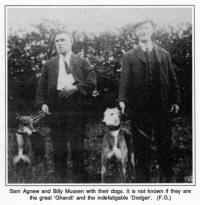
A tale attributed to Billy, and I can fancy I see
the gleam in his eye, and the grin lurking beneath
his ragged moustache, as he would tell the tale of
how a big storm blew down the shed which housed his
big billygoat. Until he got his shed repaired, and
because the weather was extremely cold, he kept the
goat in a spare bedroom at night where, according to
Billy, he got the odd mouthful of straw out of the
old mattress. News of the goat's habitation came to
the ears of the priest and he inquired of Billy if
it was true. Billy assured him that it was, to which
the priest asked aghast,"But William, what about the
smell"? "Ach sure Father" replied Billy, " the old
goat soon got used to it!"
But now to Granda's second poem. Like Ghandhi the
politician and statesman, Granda saw that Ghandhi
the greyhound would also have his niche in history
when he penned the following poem about his exploits
when he won a big race at Dromara.
Come all
you young sportsmen
To my ditty attend
Who like greyhound coursing
And have money to spend
If you bet upon Ghandhi
You will never complain
I am told that his owner
Lives in the Cross LaneLast boxing
Day morning
Some sportsmen did go
To the town of Dromara
Their prize dogs to show
And to carry the laurels
In triumph away
But when they met Ghandhi
They met with dismay The betting was
even
To the coursing begun
From that to the finish
You gave two to get one. |
And when the boys saw
him
they knew what to do
For they all backed on Ghandhi
that was owned by Agnew.For this
Ghandhi's a dog
of great fame and renown
Well known by all sportsmen
in the County of Down
His equal for coursing
no-one ever saw
Since the Rose of Old England
or bold Master McGraw For when Ghandhi
started
Away he did fly
As fast as the lightening
He passed them all by
He has conquered before
and will conquer again
And has carried the laurels
Home to the Cross Lane. |
Can I say in conclusion that I think my granda, like Ghandi, was `some
pup' too
 |